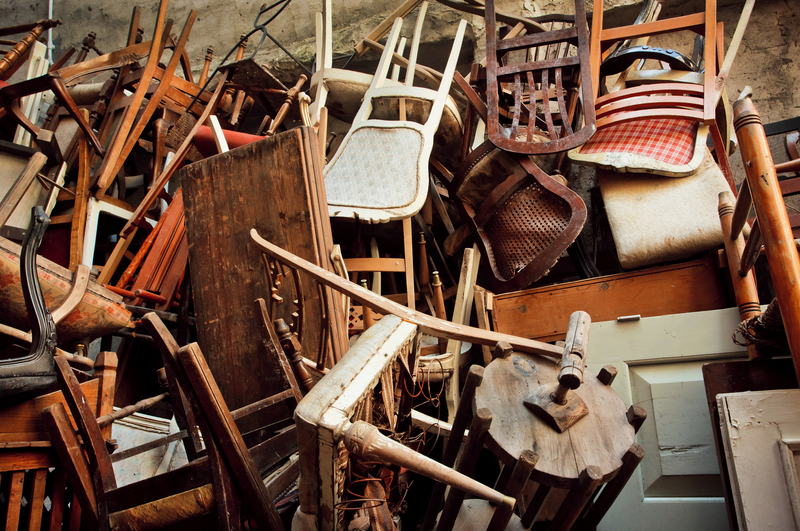Sofa Survival Guide: Expert Tips for Long-Term Storage
Posted on 17/05/2025
Sofa Survival Guide: Expert Tips for Long-Term Storage
Whether you're moving, downsizing, or simply needing extra space, storing your sofa for an extended period is a serious consideration. Improper storage can dramatically affect your couch's appearance, comfort, and structural integrity. In this Sofa Survival Guide, you'll discover the most effective, expert-backed steps for long-term sofa storage, ensuring your cherished furniture remains pristine, comfortable, and ready for use when needed once again.

Why Proper Sofa Storage Matters
Many homeowners and renters underestimate the risks associated with long-term furniture storage. Sofas, in particular, are vulnerable to moisture, pests, dust, mold, and physical deformation. Without proper couch storage techniques, your beloved lounge may emerge from storage faded, sagging, or even unusable. Taking the right steps to preserve your sofa in storage is crucial both for protecting your investment and maintaining your indoor aesthetic.
Common Risks of Improper Sofa Storage
- Mold and Mildew: Caused by humid, damp conditions.
- Fabric Fading: Sunlight and chemical exposure reduce vibrancy.
- Sagging and Warping: Incorrect positioning affects frame and cushions.
- Pest Infestations: Rodents and insects can cause physical damage and unpleasant odors.
- Permanent Dents and Odors: Due to compression or environmental factors.
To avoid these pitfalls, follow our comprehensive sofa storage tips for long-term scenarios.
Step-By-Step Sofa Storage Preparation
Proper preparation is the cornerstone of effective sofa storage. Here's a detailed approach to ensure your sofa survives months--or even years--in a storage facility or garage.
1. Thoroughly Clean the Sofa
- Vacuum Deeply: Use a vacuum cleaner, especially the crevice tool, to remove crumbs, dust, and pet hair from all cushions, seams, and crevices.
- Spot Treat Stains: For fabric sofas, use a mild upholstery cleaner; for leather couches, use a leather-safe solution. Don't forget the arms and back!
- Dry Completely: Any retained moisture can lead to mold growth and odors. Allow the sofa to air-dry entirely before moving forward.
- Polish Wood/Metal Elements: Wipe wooden or metal legs with appropriate cleaners to prevent rust or cracking during storage.
2. Disassemble When Possible
- Remove Loose Parts: Take off removable cushions, pillows, and slipcovers. Store these in sealed, labeled bags.
- Break Down the Frame: If your sofa's legs or arms can be unscrewed or removed, do so - this reduces the risk of breaking during transport or storage.
- Bag and Label Hardware: Store screws and bolts in zip bags marked with tape. Tape bags to the sofa frame so everything is easy to reassemble.
3. Choose the Right Storage Space
- Climate-Controlled Storage is Best: Temperature fluctuations and humidity are the enemies of upholstered furniture. Invest in a climate-controlled unit to maintain a consistent environment.
- Clean and Dry Area: Sweep and mop the storage space. Ensure no leaks or dampness are present.
- Elevate Your Sofa: Use wooden pallets to lift the couch off the ground; this protects it from potential floods and encourages air circulation underneath.
4. Wrap and Protect the Sofa Properly
- Use Breathable Covers: Avoid plastic wrap for fabric sofas as it can trap moisture. Instead, use specially designed sofa storage covers or old cotton sheets.
- Protect Corners and Legs: Wrap bubble wrap or thick blankets around fragile areas to guard against dings, knocks, and scratches.
- Avoid Over-Wrapping: Allow some airflow; a completely airtight seal can actually cause condensation and mold issues.
Expert Storage Tips for Couches & Sofas
Beyond the basics, industry experts offer additional pointers for keeping your couch in excellent condition throughout long-term storage.
Store Vertically or Horizontally?
- Never store your sofa on its side or standing up for extended periods - this can permanently warp the frame. Always store sofas flat and in a natural position.
Avoid Stacking Boxes or Heavy Items
- Do not pile anything on top of or against your sofa. Prolonged pressure can compress foam, create indentations, or damage the upholstery.
Use Moisture and Pest Controls
- Desiccant Packs: Place silica gel or activated charcoal packets underneath and around the sofa to absorb excess moisture.
- Cedar Blocks or Lavender Pouches: Tuck these in corners to repel pests naturally.
Regularly Check on Stored Sofas
- Inspect every few months for signs of moisture, mold, or pests. Catching potential issues early can prevent irreparable damage.
Sofa Storage Solutions: Answers to Frequently Asked Questions
How long can a sofa be stored without damage?
With correct preparation and climate control, sofas can remain in storage for many months or even years. However, fabric and cushioning materials can gradually deteriorate over time, so plan ahead and monitor conditions. Regular inspections are key!
Is it safe to wrap my couch in plastic during storage?
While plastic seems like a good idea, it can actually trap moisture leading to mildew and mold on upholstery. Use breathable covers or cotton sheets instead, especially for fabric sofas. For leather couches, plastic can cause cracking during temperature changes; avoid it unless you use specifically designed breathable plastic wraps.
Should I clean my sofa before storing?
Absolutely! Any dirt, oils, or crumbs left behind could attract pests and cause stains to set permanently during long-term storage.
Can I store my sofa in a garage or shed?
Only use these areas as a last resort, since they're rarely climate-controlled or properly sealed. Extreme temperature swings, rodents, and moisture can cause severe damage. If you must use a garage, elevate the sofa and use ample pest deterrent measures.
Special Considerations for Different Sofa Materials
Storing Leather Sofas
- Condition the Leather: Apply a leather conditioner before wrapping to prevent drying and cracking.
- No Direct Plastic: Never wrap leather in plastic. Use soft blankets or padded covers.
- Avoid Sunlight: Sun can fade and dry out leather, even during storage. Choose a dark, shaded location.
Storing Fabric Couches
- Deep Clean: Remove all stains before storage, as they may worsen and set over time.
- Protect with Cotton Sheets: These allow the fabric to breathe while guarding against dust and insects.
- Odor Control: Store with odor-absorbing items such as baking soda sachets or fabric-safe deodorizers.
Storing Sectionals and Modular Sofas
- Disassemble: Break down into separate pieces for easier moving and less risk of structural damage.
- Label Each Piece: Number or mark components for quick and easy reassembly.
- Wrap Components Individually: This guards against scratches and dings during transport and storage.
Restoring Your Sofa After Long-Term Storage
When you're ready to bring your couch back into everyday use, follow these steps for a fresh start:
- Unwrap Carefully: Use scissors, not knives, to avoid cutting the upholstery.
- Vacuum and Spot Clean: Dust away any particles and consider steam cleaning for fabric or conditioning for leather.
- Check for Odors: If mild mustiness is present, sprinkle baking soda and let sit for several hours before vacuuming. Use fabric-safe fresheners if needed.
- Air Out in Sunlight: Short periods in mild sunlight can kill lingering bacteria and freshen upholstery, but avoid prolonged exposure to prevent fading.
- Inspect for Mold or Damage: Address any issues immediately to prevent spreading or worsening damage.
- Reassemble and Enjoy: Put cushions, legs, and hardware back in place--your sofa is ready for use!

Best Practices in Sofa Storage: Recap
- Always clean and dry your sofa before storage.
- Disassemble parts where possible.
- Select a climate-controlled, clean location.
- Protect with breathable wraps and padding.
- Keep off the ground and never stack items on top.
- Use pest and moisture deterrents.
- Inspect periodically to catch any problems early.
Sofa Survival Guide: Protect Your Couch for the Long Haul
Sofas are more than just places to sit--they're investments and part of your home's character. Proper long-term sofa storage ensures that your couch stays comfortable, beautiful, and functional for years to come. Always choose quality storage facilities, use expert-approved techniques, and never underestimate the importance of preparation. Your sofa--and your future self--will thank you!
For more couch storage ideas, furniture care tips, and home organization guides, explore our blog and discover additional resources to make your next move or renovation simple and stress-free.
Have questions about storing a particular type or brand of sofa? Leave your comment below or contact our furniture storage experts for personalized advice!



